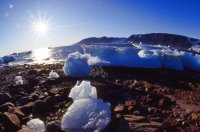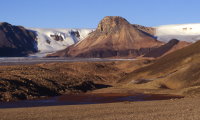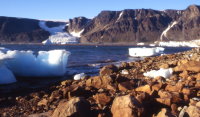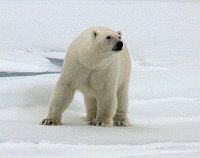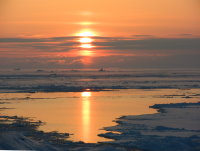North-West Passage
The Legendary Route and Polar Challenge - 17 days
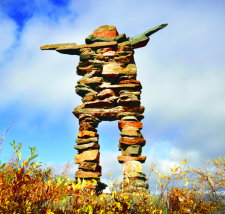 |
|
Travel the route that obsessed explorers for centuries
|
|
|
Enjoy the legendary hospitality of vibrant Inuit communities
|
|
|
Find and photograph the wild creatures of the Arctic wilderness
|
|
|
Experience the Arctic with our expert artists, lecturers and hosts
|
|
|
Visit the historic graves of the ill fated Franklin Expedition
|
|
|
Visit the largest uninhabited island on earth during our stop at Devon Island
|
The Northwest Passage is the pinnacle of Arctic exploration; on this tour, we go where the ice allows. We’ll explore the quaint villages, dramatic fjords and calving glaciers of Greenland, working our way north to spectacular Kap York. Crossing Smith Sound we’ll visit Aujuittuq (Grise Fiord), Canada’s northernmost community. The bird cliffs at Coburg Island, a National Wildlife Area teem with kittiwakes and murres.
At Beechey Island, the Franklin expedition gravestones stand watch. Melville, Banks and Devon Islands offer great opportunities to observe caribou, polar bear, walrus and musk ox. We'll visit ghostly RCMP and Hudson Bay Company posts. Prince of Wales Strait affords a striking, narrow passage to the Amundsen Gulf and our final destination: Kugluktuk
(Coppermine) - the end to an epic journey above the Arctic Circle.
At Beechey Island, the Franklin expedition gravestones stand watch. Melville, Banks and Devon Islands offer great opportunities to observe caribou, polar bear, walrus and musk ox. We'll visit ghostly RCMP and Hudson Bay Company posts. Prince of Wales Strait affords a striking, narrow passage to the Amundsen Gulf and our final destination: Kugluktuk
(Coppermine) - the end to an epic journey above the Arctic Circle.
Itinerary
1.day: Kangerlussuaq
Kangerlussuaq, the start of our voyage, is appropriately named. The word means 'The Big Fjord' in Greenlandic, aptly describing this amazing feature, 168km long!
Lying at the head of the longest fjord in western Greenland, Kangerlussuaq has one of the most stable climates in the region—though temperatures can range from -50C in the winter to as high as 28C in summer.
2. day Sisimiut Coast, Greenland
The west Greenland coastline is a rich mixture of fishing communities, myriads of islands and complex coastal waterways.
We will be making an expedition stop here to explore the Greenlandic landscape
1.day: Kangerlussuaq
Kangerlussuaq, the start of our voyage, is appropriately named. The word means 'The Big Fjord' in Greenlandic, aptly describing this amazing feature, 168km long!
Lying at the head of the longest fjord in western Greenland, Kangerlussuaq has one of the most stable climates in the region—though temperatures can range from -50C in the winter to as high as 28C in summer.
2. day Sisimiut Coast, Greenland
The west Greenland coastline is a rich mixture of fishing communities, myriads of islands and complex coastal waterways.
We will be making an expedition stop here to explore the Greenlandic landscape
3. day: Ilulissat
Venturing 250km north of the Arctic Circle we find the stunning coastal community of Ilulissat. Ilulissat translates literally into "iceberg", and there couldn't be a more fitting name.
Our visit will include time in the colourful town and a chance to hike out to an elevated viewpoint where we can observe the great fields of ice. We will also cruise with our fleet of zodiacs into the UNESCO World Heritage Site of the Ilulissat Icefjord.
The Icefjord is where we find the Sermeq Kujalleq Glacier, one of the most active and fastest moving in the world at 19m per day and calving more than 35 square kilometers of ice annually. The glacier has been the object of scientific attention for 250 years.
Venturing 250km north of the Arctic Circle we find the stunning coastal community of Ilulissat. Ilulissat translates literally into "iceberg", and there couldn't be a more fitting name.
Our visit will include time in the colourful town and a chance to hike out to an elevated viewpoint where we can observe the great fields of ice. We will also cruise with our fleet of zodiacs into the UNESCO World Heritage Site of the Ilulissat Icefjord.
The Icefjord is where we find the Sermeq Kujalleq Glacier, one of the most active and fastest moving in the world at 19m per day and calving more than 35 square kilometers of ice annually. The glacier has been the object of scientific attention for 250 years.
4. day: Karrat Fjord
In Karrat Fjord we will cruise through one of Greenland's most spectacular fjords. During ice breakup, narwhals and seals use the long leads created by high winds in this region to hunt the rich waters of the fjord.
The cliffs within the fjord should give us good opportunities to see colonies of dovekies.
Time spent on deck today will likely result in some good wildlife sightings, not to mention unbeatable photographic opportunities
5. day: Melville Bay
Melville Bay (Greenlandic: Qimusseriarsuaq), is a large bay off the coast of northwestern Greenland. Located to the north of the Upernavik Archipelago, it opens to the south-west into Baffin Bay. Its Kalaallisut name, Qimusseriarsuaq, means "the great dog sledding place".
6. day: Kap York
The rugged coastal environment at Kap York is rich in wildlife and is part of an extensive network of traditional hunting grounds.
During the spring and summer months the skies and cliffs are dotted with millions of birds, primarily auks and murres. This district boasts the largest seabird population in northwest Greenland.
Whalers and explorers often entered these waters and later Admiral Robert Peary's family raised a monument in honour of his achievements on the cape. Sailors' and ships' logs record multiple climbs of the cape in order to survey the ice conditions in Qimusseriarsuaq.
In Karrat Fjord we will cruise through one of Greenland's most spectacular fjords. During ice breakup, narwhals and seals use the long leads created by high winds in this region to hunt the rich waters of the fjord.
The cliffs within the fjord should give us good opportunities to see colonies of dovekies.
Time spent on deck today will likely result in some good wildlife sightings, not to mention unbeatable photographic opportunities
5. day: Melville Bay
Melville Bay (Greenlandic: Qimusseriarsuaq), is a large bay off the coast of northwestern Greenland. Located to the north of the Upernavik Archipelago, it opens to the south-west into Baffin Bay. Its Kalaallisut name, Qimusseriarsuaq, means "the great dog sledding place".
6. day: Kap York
The rugged coastal environment at Kap York is rich in wildlife and is part of an extensive network of traditional hunting grounds.
During the spring and summer months the skies and cliffs are dotted with millions of birds, primarily auks and murres. This district boasts the largest seabird population in northwest Greenland.
Whalers and explorers often entered these waters and later Admiral Robert Peary's family raised a monument in honour of his achievements on the cape. Sailors' and ships' logs record multiple climbs of the cape in order to survey the ice conditions in Qimusseriarsuaq.
7. day: Smith Sound
We will spend a day exploring north into this fabled body of water that served as the main route for explorers and adventurers searching for the North Pole. Adolphus Greely, Sir George Nares and Elisha Kent Kane all travelled these waters with varying degrees of success.
Only 48-72km wide and 88km long, Smith Sound is often packed with ice and provides favourable conditions for wildlife viewing.
8. day: Aujuittuq (Grise Fiord)
Aujuittuq means 'place that never thaws.' That's apt for this peaceful hamlet, 1,150km above the Arctic Circle - Canada's northernmost civilian community. We'll be welcomed by the population of about 165 souls.
Our activities will centre on the school where we will have a chance to meet members of the community and learn about their way of life.
We will spend a day exploring north into this fabled body of water that served as the main route for explorers and adventurers searching for the North Pole. Adolphus Greely, Sir George Nares and Elisha Kent Kane all travelled these waters with varying degrees of success.
Only 48-72km wide and 88km long, Smith Sound is often packed with ice and provides favourable conditions for wildlife viewing.
8. day: Aujuittuq (Grise Fiord)
Aujuittuq means 'place that never thaws.' That's apt for this peaceful hamlet, 1,150km above the Arctic Circle - Canada's northernmost civilian community. We'll be welcomed by the population of about 165 souls.
Our activities will centre on the school where we will have a chance to meet members of the community and learn about their way of life.
9. day: Coburg Island
At the entrance to Jones Sound is Coburg Island, whose spectacular seabird cliffs are a designated National Wildlife Area.
30,000 pairs of black-legged kittiwakes and 160,000 pairs of thick-billed murres crowd the rocky ledges on this island almost completely covered by an ice cap.
10. day: Devon Island
The largest uninhabited island in the world supports significant concentrations of wildlife, including 26 species of seabirds and 11 species of marine mammals.
At Dundas Harbour we find the lonely remains of an RCMP station dating from the 1920s. We have also spotted walrus, polar bear, muskox and caribou here.
At nearby Croker Bay, we have a chance to Zodiac cruise through this scenic bay and marvel at icebergs, freshly calved from the glacier at the head of the bay.
At the entrance to Jones Sound is Coburg Island, whose spectacular seabird cliffs are a designated National Wildlife Area.
30,000 pairs of black-legged kittiwakes and 160,000 pairs of thick-billed murres crowd the rocky ledges on this island almost completely covered by an ice cap.
10. day: Devon Island
The largest uninhabited island in the world supports significant concentrations of wildlife, including 26 species of seabirds and 11 species of marine mammals.
At Dundas Harbour we find the lonely remains of an RCMP station dating from the 1920s. We have also spotted walrus, polar bear, muskox and caribou here.
At nearby Croker Bay, we have a chance to Zodiac cruise through this scenic bay and marvel at icebergs, freshly calved from the glacier at the head of the bay.
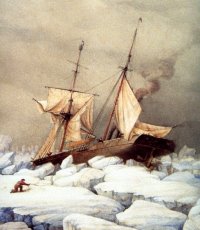 |
11. day: Beechey Island
In 1845 Sir John Franklin took his expedition of 129 men in two ships into the Wellington Channel. Not a soul returned from the fateful expedition. It was two years before search parties were launched.
Aside from the bodies of three souls buried here, only relics were found as clues to the disappearance. Until recently, the three graves had left no indication as to the fate of the rest of the British party.
Such is the interest in this story, the Canadian government recently announced a new initiative to locate the missing Franklin vessels.
12. day: : Bathurst Island
Good soil conditions and a rare wetland environment produce abundant vegetation here, making Bathurst a major calving area for the endangered Peary Caribou.
Here we also find the Polar Bear National Wildlife Area, a migratory route for polar bears from March to November. The north half of the island is the proposed Tuktusiuqvialuk National Park.
There is a long human history on the island, with evidence of Dorset and Thule habitation as early as 2,000 BC.
In 1845 Sir John Franklin took his expedition of 129 men in two ships into the Wellington Channel. Not a soul returned from the fateful expedition. It was two years before search parties were launched.
Aside from the bodies of three souls buried here, only relics were found as clues to the disappearance. Until recently, the three graves had left no indication as to the fate of the rest of the British party.
Such is the interest in this story, the Canadian government recently announced a new initiative to locate the missing Franklin vessels.
12. day: : Bathurst Island
Good soil conditions and a rare wetland environment produce abundant vegetation here, making Bathurst a major calving area for the endangered Peary Caribou.
Here we also find the Polar Bear National Wildlife Area, a migratory route for polar bears from March to November. The north half of the island is the proposed Tuktusiuqvialuk National Park.
There is a long human history on the island, with evidence of Dorset and Thule habitation as early as 2,000 BC.
13. day: Melville Island
Melville Island was first visited by British explorer Sir William Parry in 1819. Not only did he discover the island; ice forced him to spend the winter in 1820 at what is now called 'Winter Harbour'.
The island is named for Robert Dundas, 2nd Viscount Melville, who was First Sea Lord at the time.
Melville Island is one of two major breeding grounds for a small sea goose, the Western High Arctic Brant. DNA analysis and field observations suggest that these birds may be distinct from other Brant stocks. Numbering only 4,000-8,000 birds, this is one of the rarest goose stocks in the world.
Day 14: Banks Island
Home to two thirds of the world's population of Lesser Snow Geese, two federal Migratory Bird Sanctuaries were founded in 1961. The island is home to barren-ground caribou, polar bears, muskoxen, and birds such as robins and swallows.
The first grizzly-polar bear hybrid found in the wild, was sighted on Banks Island in April 2006, near Sachs Harbour.
Muskoxen, with a population of about 40,000, are the most striking of the abundant wildlife on the island. It was named Banks Island in 1820 by Sir William Parry in honour of British naturalist and botanist Sir Joseph Banks.
Day 15: Prince of Wales Strait
Prince of Wales Strait is part of the Arctic Ocean, extending northeastward for 275 km from the Amundsen Gulf to Viscount Melville Sound and separating Banks and Victoria Islands. It was discovered in 1850 by Robert McClure, the Irish explorer, who came within sight of the Viscount Melville Sound before heavy ice forced him to turn back.
Named after Albert Edward, then the Prince of Wales, it was not navigated until the RCMP patrol of Sgt Larsen in 1944. It has since become the preferred route of large vessels making the passage.
Melville Island was first visited by British explorer Sir William Parry in 1819. Not only did he discover the island; ice forced him to spend the winter in 1820 at what is now called 'Winter Harbour'.
The island is named for Robert Dundas, 2nd Viscount Melville, who was First Sea Lord at the time.
Melville Island is one of two major breeding grounds for a small sea goose, the Western High Arctic Brant. DNA analysis and field observations suggest that these birds may be distinct from other Brant stocks. Numbering only 4,000-8,000 birds, this is one of the rarest goose stocks in the world.
Day 14: Banks Island
Home to two thirds of the world's population of Lesser Snow Geese, two federal Migratory Bird Sanctuaries were founded in 1961. The island is home to barren-ground caribou, polar bears, muskoxen, and birds such as robins and swallows.
The first grizzly-polar bear hybrid found in the wild, was sighted on Banks Island in April 2006, near Sachs Harbour.
Muskoxen, with a population of about 40,000, are the most striking of the abundant wildlife on the island. It was named Banks Island in 1820 by Sir William Parry in honour of British naturalist and botanist Sir Joseph Banks.
Day 15: Prince of Wales Strait
Prince of Wales Strait is part of the Arctic Ocean, extending northeastward for 275 km from the Amundsen Gulf to Viscount Melville Sound and separating Banks and Victoria Islands. It was discovered in 1850 by Robert McClure, the Irish explorer, who came within sight of the Viscount Melville Sound before heavy ice forced him to turn back.
Named after Albert Edward, then the Prince of Wales, it was not navigated until the RCMP patrol of Sgt Larsen in 1944. It has since become the preferred route of large vessels making the passage.

Day 16: Ulukhaktok (Holman)
Found on the west side of Victoria Island, The Hudson's Bay Company post at Prince Albert Sound was opened in 1923, moved to Walker Bay in 1928 and finally to Ulukhaktok (Holman) in 1939.
The large bluff that overlooks Ulukhaktok was the source that provided the slate and copper used to make ulu’s and give the community its name.
Ulukhaktok is also the location of the most northern golf course in the Americas and hosts the "Billy Joss Open Celebrity Golf Tournament" every summer. Over the years they have managed to attract players from the Edmonton Oilers and the Edmonton Eskimos, as well as golfers from other countries.
Found on the west side of Victoria Island, The Hudson's Bay Company post at Prince Albert Sound was opened in 1923, moved to Walker Bay in 1928 and finally to Ulukhaktok (Holman) in 1939.
The large bluff that overlooks Ulukhaktok was the source that provided the slate and copper used to make ulu’s and give the community its name.
Ulukhaktok is also the location of the most northern golf course in the Americas and hosts the "Billy Joss Open Celebrity Golf Tournament" every summer. Over the years they have managed to attract players from the Edmonton Oilers and the Edmonton Eskimos, as well as golfers from other countries.
Day 17: Kugluktuk (Coppermine)
Located at the mouth of the Coppermine River, southwest of Victoria Island on the Coronation Gulf, Kugluktuk is the western most community in Nunavut. Originally named Coppermine, it was renamed Kugluktuk according to its Inuinnaqtun name meaning "place of moving waters", on January 1st, 1996.
The Coppermine River itself is designated a Canadian Heritage River for the important role it played as an exploration and fur trade route. Copper deposits along the river attracted the first explorers to the area.
Because the tundra is close to the tree line, a variety of wildlife can be viewed in the area, including grizzly bears, wolverines and moose, as well as tundra wildlife, such as muskoxen, caribou, foxes and wolves. We disembark in Coppermine
Located at the mouth of the Coppermine River, southwest of Victoria Island on the Coronation Gulf, Kugluktuk is the western most community in Nunavut. Originally named Coppermine, it was renamed Kugluktuk according to its Inuinnaqtun name meaning "place of moving waters", on January 1st, 1996.
The Coppermine River itself is designated a Canadian Heritage River for the important role it played as an exploration and fur trade route. Copper deposits along the river attracted the first explorers to the area.
Because the tundra is close to the tree line, a variety of wildlife can be viewed in the area, including grizzly bears, wolverines and moose, as well as tundra wildlife, such as muskoxen, caribou, foxes and wolves. We disembark in Coppermine
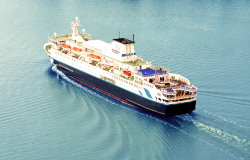 |
Notes
The itinerary above is just a suggestion. The actual ice- and weather-conditions might - for safety reasons - result in a change of the scheduled program. An iconic journey, the Northwest Passage remains an adventure today
Sailing with a maximum of 198-passengers, Ocean Endeavour is the perfect vessel for expedition cruising..Equipped with twenty Zodiacs, advanced navigation equipment, multiple lounges and a top deck observation room, she is purpose-built for passenger experiences in remote environments.
The itinerary above is just a suggestion. The actual ice- and weather-conditions might - for safety reasons - result in a change of the scheduled program. An iconic journey, the Northwest Passage remains an adventure today
Sailing with a maximum of 198-passengers, Ocean Endeavour is the perfect vessel for expedition cruising..Equipped with twenty Zodiacs, advanced navigation equipment, multiple lounges and a top deck observation room, she is purpose-built for passenger experiences in remote environments.


